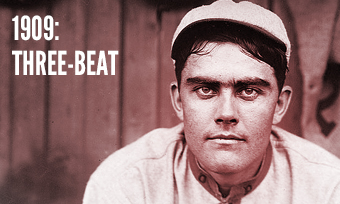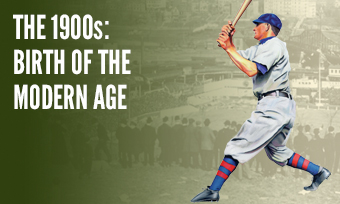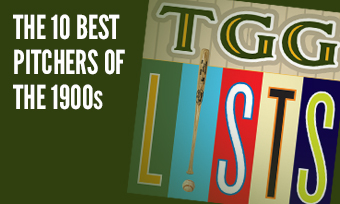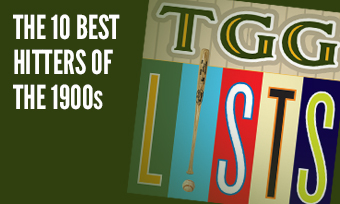The Yearly Reader
Leaders and Honors, 1909
Our list of baseball’s top 10 hitters and pitchers in both the American League and National League for the 1909 baseball season, as well as the awards and honors given to the game’s top achievers of the year.
The National League’s Top 10 Hitters, 1909
Bold type in brick red indicates league leader.
1. Honus Wagner, Pittsburgh
Key Numbers: .339 average, 92 runs, 39 doubles, 10 triples, 5 home runs, 100 RBIs, 35 stolen bases
It was clean sweep for the Flying Dutchman, who finished the decade #1 on this list in every season.
2. Mike Mitchell, Cincinnati
Key Numbers: .310 average, 83 runs, 17 triples, 4 home runs, 86 RBIs, 37 stolen bases.
The lanky slugger re-emerged to form after a dreadful, injury-plagued sophomore effort in 1908 when he hit only .222.
3. Fred Clarke, Pittsburgh
Key Numbers: .287 average, 97 runs, 68 RBIs, 80 walks, 31 stolen bases.
In was all vintage for the NL champion Pirates and for player-manager Clarke, who at age 36 logged the most games (152) of his career and made them all count.
4. Ed Konetchy, St. Louis
Key Numbers: .286 average, 88 runs, 14 triples, 80 RBIs, 65 walks.
The Lacrosse, Wisconsin native had the body to play that sport; he was also developing into the NL’s premier defensive first baseman.
5. Larry Doyle, New York
Key Numbers: .302 average, 86 runs, 172 hits, 27 doubles, 11 triples, six home runs.
The young and excitable star impressed Giants manager John McGraw enough that he was named the team captain at age 22.
6. Red Murray, New York
Key Numbers: .263 average, 12 triples, 7 home runs, 91 RBIs, 48 stolen bases.
Despite a tepid batting average, Murray had enough clout to become the first Giant to have sole possession of the NL home run title since Buck Ewing, way back in 1883.
7. Tommy Leach, Pittsburgh
Key Numbers: .261 average, 126 runs, 29 doubles, 8 triples, 6 home runs, 66 walks, 27 stolen bases.
Yet another member of the Pirates’ old guard who showed they were far from done, Leach led the majors in runs scored.
8. Sherry Magee, Philadelphia
Key Numbers: .270 average, 33 doubles, 14 triples, 66 RBIs, 43 stolen bases.
With little protection once again in the Phillies’ lineup, Magee made the best of an iffy situation. That would soon change.
9. Dots Miller, Pittsburgh
Key Numbers: .279 average, 31 doubles, 13 triples, 3 home runs, 87 RBIs, 29 sacrifice hits.
The rookie second baseman was one of the new guys on the Pirates’ block (along with Babe Adams and Chief Wilson) to successfully complement the aging-like-fine-wine vets.
10. Dick Hoblitzell, Cincinnati
Key Numbers: .308 average, 23 doubles, 11 triples, 4 home runs, 67 RBIs, 29 sacrifice hits.
In a year strong on newcomers, the 20-year-old West Virginia native was probably one of the more underrated.
The American League’s Top 10 Hitters, 1909
1. Ty Cobb, Detroit
Key Numbers: .377 average, 116 runs, 216 hits, 33 doubles, 10 triples, 9 home runs, 107 RBIs, 76 stolen bases.
Taking his career into high gear, Cobb became a triple-crown winner by nabbing the only home run title—with all nine round-trippers hit inside the park.
2. Eddie Collins, Philadelphia
Key Numbers: .347 average, 104 runs, 198 hits, 30 doubles, 10 triples, 62 walks, 63 stolen bases.
Finishing second in the AL batting race to Cobb—as he often would—the young second baseman exploded onto the scene, hitting .408 in June and stealing 36 of his bases over the season’s last two months.
3. Sam Crawford, Detroit
Key Numbers: .314 average, 185 hits, 35 doubles, 14 triples, 6 home runs, 97 RBIs.
The six-time leader in triples paced the AL in doubles for the only time in his career.
4. Tris Speaker, Boston
Key Numbers: .309 average, 26 doubles, 13 triples, 7 home runs, 77 RBIs.
Like Eddie Collins (above), Speaker rose as yet another hot new name to initiate an elite and lengthy career; for the only time in his Hall-of-Fame career, he’d rack up more strikeouts (53) than walks (38).
5. Frank Baker, Philadelphia
Key Numbers: .305 average, 27 doubles, 19 triples, 4 home runs, 85 RBIs, 34 sacrifice hits.
The man soon to be nicknamed for the home run was, for now, apparently concentrating on the triple—leading the AL in that department.
6. Donie Bush, Detroit
Key Numbers: .273 average, 157 games, 115 runs, 88 walks, 53 stolen bases, 52 sacrifice hits.
The petite (5’6”, 140 lbs.) Bush couldn’t slug for much with just 20 extra-base hits and no home runs, but he knew how to get on base via the walk—and then score.
7. Patsy Dougherty, Chicago
Key Numbers: .285 average, 13 triples, 36 stolen bases.
As the White Sox took a much-needed refresher course in hitting, Dougherty was ahead of the learning curve by outhitting his teammates, .285 to .214.
8. Jake Stahl, Boston
Key Numbers: .294 average, 12 triples, 6 home runs, 15 hit-by-pitches.
The Red Sox were happy to keep Stahl, who was as gifted at banking as he was at baseball, happy enough to continue to make the game his day job…for now.
9. Harry Davis, Philadelphia
Key Numbers: .268 average, 11 triples, 4 home runs, 75 RBIs, 20 stolen bases.
The veteran A’s infielder still had enough juice left to welcome in the future members of the “$100,000 Infield.”
10. Danny Murphy, Philadelphia
Key Numbers: .281 average, 28 doubles, 14 triples, 5 home runs, 69 RBIs, 34 sacrifice hits.
Ditto Davis, above.
The National League’s Top 10 Pitchers, 1909
1. Three Finger Brown, Chicago
Key Numbers: 1.31 ERA, 27 wins, 9 losses, 7 saves, 50 appearances, 342.2 innings.
The disfigured wonder capped an impressive four-year run in which he won 102 games, lost 30 and recorded an overall 1.31 ERA.
2. Christy Mathewson, New York
Key Numbers: 1.14 ERA, 25 wins, 6 losses, .806 win percentage, 275.1 innings.
While many pitchers would be thrilled to hold opposing hitters to a .228 batting average, that’s what Mathewson allowed for an on-base percentage in the year of his lowest-ever ERA.
3. Howie Camnitz, Chicago
Key Numbers: 1.62 ERA, 25 wins, 6 losses, .806 win percentage, 283 innings.
Nicknamed the Kentucky Rosebud, Camnitz bloomed to match Mathewson’s record (and league-leading win percentage).
4. Orvie Overall, Chicago
Key Numbers: 1.42 ERA, 20 wins, 11 losses, 205 strikeouts, 285 innings.
Proving once again in the deadball’s reign that posting an ERA in the low 1.00s didn’t guarantee you the team lead—let alone the league lead—Overall finished second behind Three Finger Brown. But his 205 Ks were the most by a Cub until Ferguson Jenkins, 58 years later.
5. Art Fromme, Cincinnati
Key Numbers: 1.90 ERA, 19 wins, 13 losses, 279.1 innings.
After successive 5-13 campaigns with the lowly Cardinals, Fromme developed a rare case of pitching over .500.
6. Ed Reulbach, Chicago
Key Numbers: 1.78 ERA, 19 wins, 10 losses.
Posting his fourth sub-2.00 ERA in five years, Reulbach’s 1.78 figure was actually higher than that of the team’s 1.75—the second lowest in major league history.
7. Vic Willis, Pittsburgh
Key Numbers: 2.24 ERA, 22 wins, 11 losses, 35 starts, 289.2 innings.
The future Hall of Famer enjoyed his final fling of fun with the Pirates before being sent to the low-rent Cardinals, with whom he quickly hit a wall and the end of his career.
8. Babe Adams, Pittsburgh
Key Numbers: 1.11 ERA, 12 wins, 3 losses.
A scintillating yet abbreviated debut for the pitcher arguably considered the greatest in Pirates history; he fell just 23 innings short of possibly (and officially) leading the NL in ERA and opposing batting average (.196).
9. Harry Gaspar, Cincinnati
Key Numbers: 2.01 ERA, 19 wins, 11 losses.
For one season at least, nobody in Cincinnati—or outside, for that matter—was asking, “Who the hell is Harry Gaspar?”
10. Hooks Wiltse, New York
Key Numbers: 2.00 ERA, 20 wins, 11 losses, 269.1 innings.
Wiltse hit the 20-win milestone for the second straight year and, had he allowed just one less earned run, would have joined six other National Leaguers in the sub-2.00 class.
The American League’s Top 10 Pitchers, 1909
1. Frank Smith, Chicago
Key Numbers: 1.80 ERA, 25 wins, 17 losses, 51 appearances, 40 starts, 365 innings.
With Ed Walsh (below) perhaps feeling tired after throwing 464 innings in 1908, teammate Smith admirably took over as the team’s iron man on the mound—before he, too, would burn out.
2. Ed Walsh, Chicago
Key Numbers: 1.41 ERA, 15 wins, 11 losses.
Despite missing a few months while hitters began to better figure out what pitch he’d throw next—leading to a surge in his walk rate and drop in his K rate—Walsh still came within 0.02 of earning the AL ERA title.
3. Chief Bender, Philadelphia
Key Numbers: 1.66 ERA, 18 wins, 8 losses, 250 innings.
Not a bad year for the stalwart A’s pitcher and half-Native American, considering that he’d all but decided to quit the game the winter before to focus more on trapshooting.
4. Eddie Plank, Philadelphia
Key Numbers: 1.76 ERA, 19 wins, 10 losses, 265.1 innings.
The steady veteran of the A’s furnished a career-best 1.76 ERA, a year after what would be his only sub-.500 record (excusing a 5-6 mark for the 1917 Browns in which he pitched only 131 innings).
5. George Mullin, Detroit
Key Numbers: 2.22 ERA, 29 wins, 8 losses, .784 win percentage, 303.2 innings.
The Tigers’ workhorse, who historically lost as frequently as he won, finally and deservedly got more than his share of wins.
6. Addie Joss, Cleveland
Key Numbers: 1.71 ERA, 14 wins, 13 losses.
A strong but muted swan song for Joss, though no one knew it at the time; he would die a year later after a fatal bout with meningitis.
7. Harry Krause, Philadelphia
Key Numbers: 1.39 ERA, 18 wins, 8 losses, 7 shutouts.
The A’s had four pitchers registering ERAs below 2.00, and one-shot wonder Krause had the very best of them; his seven shutouts remain one shy of a rookie record.
8. Ed Willett, Detroit
Key Numbers: 2.34 ERA, 21 wins, 10 losses, 292.2 innings.
The right-hander who refused to room with Ty Cobb for fear of not surviving the experience turned in a workhorse effort and the lone 20-win campaign of his career.
9. Ed Summers, Detroit
Key Numbers: 2.24 ERA, 19 wins, 9 losses, 281.2 innings.
A year after winning 24 games as a rookie, Willett fell one victory short of joining Mullin and Willett (above) in the 20-win club.
10. Cy Morgan, Boston-Philadelphia
Key Numbers: 1.81 ERA, 18 wins, 17 losses, 293.1 innings.
Morgan thrived for most of the year with the A’s after the Red Sox let him go following an unsuccessful half-hearted tag attempt on spike-sharp Ty Cobb.









